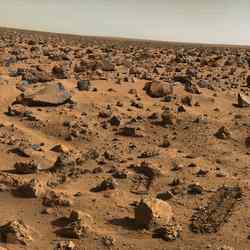
THOR will search for water ice in potentially habitable zones. Image credit: NASA Click to enlarge
A proposed new robotic mission to Mars plans to make the first exploration of subsurface water ice in a potentially habitable zone.
If approved, the Tracing Habitability, Organics and Resources (THOR) project ? a low-cost mission designed for NASA’s Mars Scout program ? aims to send a projectile at high speed into the Martian surface while observing the impact and its aftermath. The mission would be led by ASU, in partnership with the Jet Propulsion Laboratory (JPL).
The THOR mission, planned for launch in 2011, aims to use a direct approach to excavating material from beneath the surface of Mars: blasting it out.
“The mission’s goal is to expose snow and ice in a previously unexplored part of Mars: the deep subsurface,” says THOR’s principal investigator, Phil Christensen of ASU’s Mars Space Flight Facility. “We’ll do this by blowing a crater at least 30 feet deep in the Martian ground.”
Besides finding underground water, he says, THOR also proposes to look for organic compounds, including methane, which Earth-based telescopes and other Mars spacecraft have detected in the Martian atmosphere.
The mission aims to use a two-part spacecraft, which consists of an “impactor” probe and an observer craft. The impactor is a simple projectile made of pure Arizona copper. The observer spacecraft will carry it until shortly before reaching Mars. After being released from the observer, the impactor will streak through the Martian atmosphere to an impact site lying between 30 degrees and 60 degrees latitude, in either the northern or southern hemisphere of the Red Planet.
“In many areas of Mars’ middle latitudes, we see tantalizing evidence of dust-covered layers of snow or ice,” Christensen says. “THOR will aim for this material.”
The suspected ice-rich layers were deposited during the past 50,000 to 1 million years, as the Martian climate changed because of orbital variations.
According to the mission plan, when the impactor slams into the ground, it will dig a crater more than 30 feet (10 meters) deep. The observer spacecraft will study the debris plume jetting from the impact site.
The observer’s instruments will include a visible-light camera and an infrared spectrometer. In addition to studying the plume, the spectrometer’s role is to search the Martian atmosphere for organic materials and gases, such as methane.
In the past, Christensen notes, Mars has been studied using fly-by and orbiter spacecraft, and with landers. While highly valuable, such missions have only scratched the surface, he says.
“The time has come to take Martian studies a step further ? and deeper,” Christensen says. “This unexplored region of Mars may provide chemical and mineral clues to tell us about habitable areas on the planet.”
“The THOR mission plans to use a straightforward, low-risk approach to reach the Martian subsurface,” says JPL’s David Spencer, the study lead engineer for THOR.
Spencer is the former mission manager for Deep Impact, the comet mission that pioneered the impact technique.
In comparing the two missions, Spencer says, “With such a large target region on Mars, delivering THOR’s impactor will be less challenging than the Deep Impact comet encounter.”
Christensen sees THOR’s scientific value continuing far beyond the impact.
“THOR’s crater will remain a test-site for all current Mars spacecraft and those in years to come,” he says. “The crater might also be visited on the ground by a future Mars rover, sometime in the next decade.”
NASA’s Mars Scouts are competitively proposed missions designed to advance the goals of NASA’s Mars exploration program. The Mars Scout Program is managed by JPL for NASA’s Office of Space Science, based in Washington.
Original Source: ASU News Release
